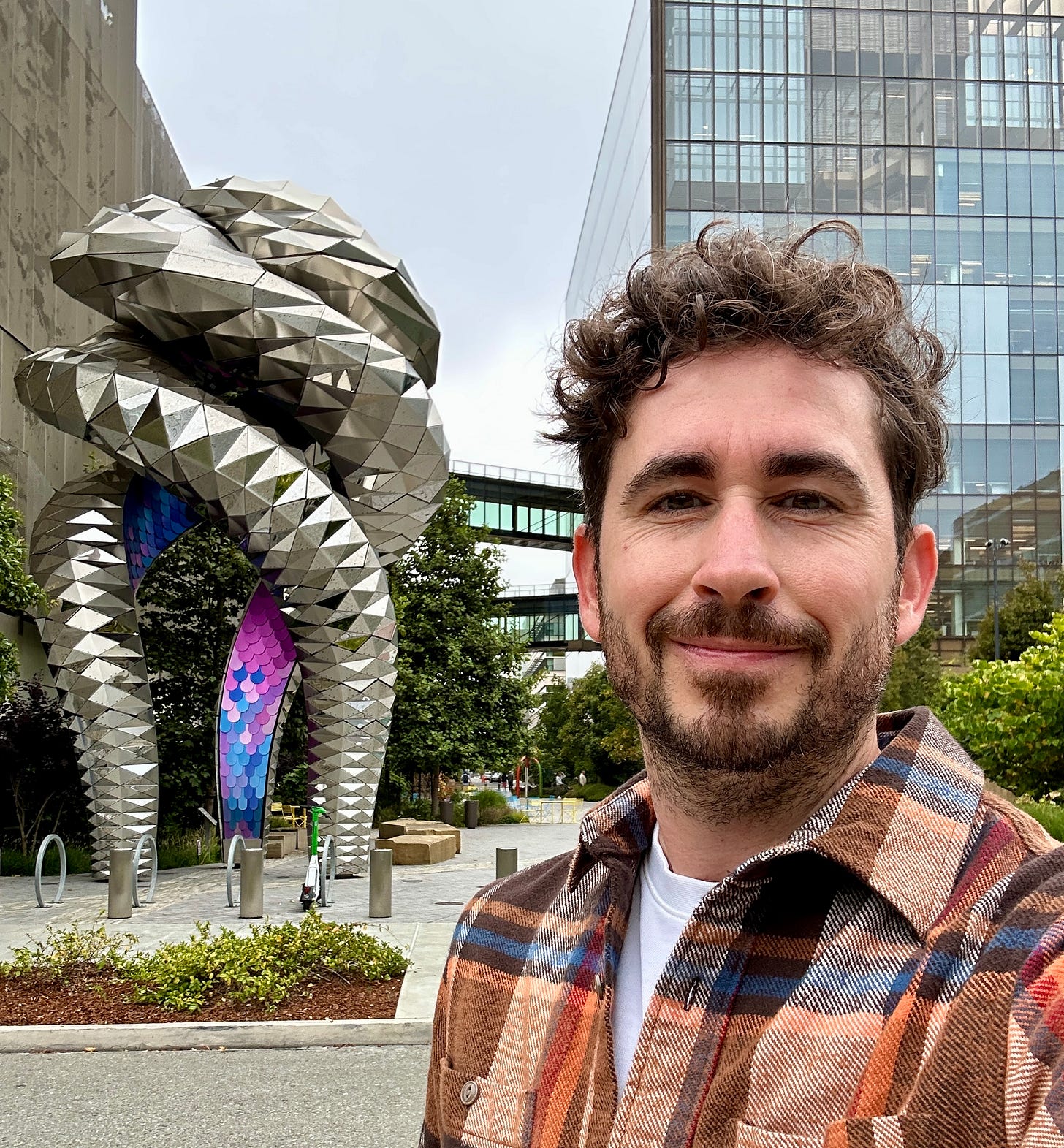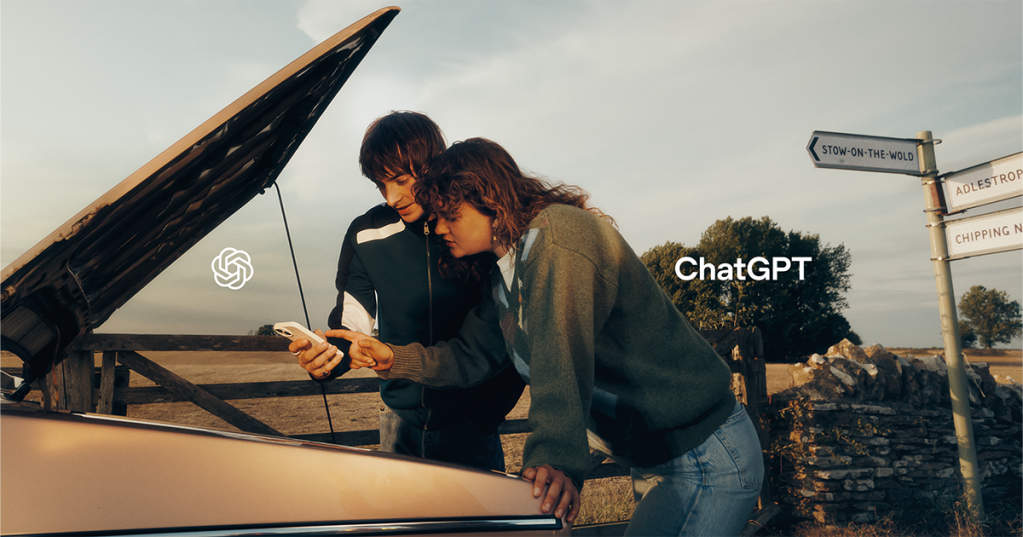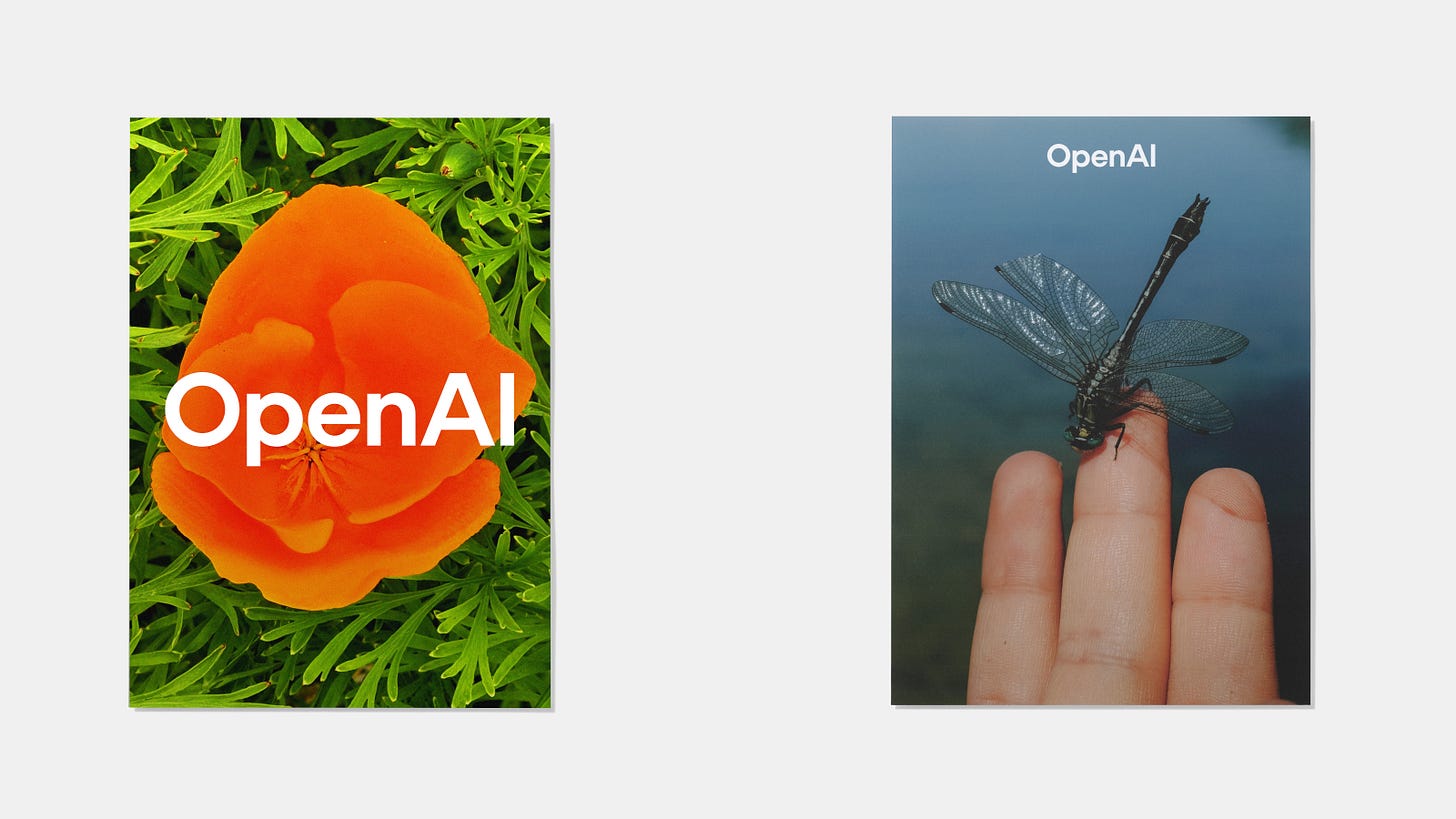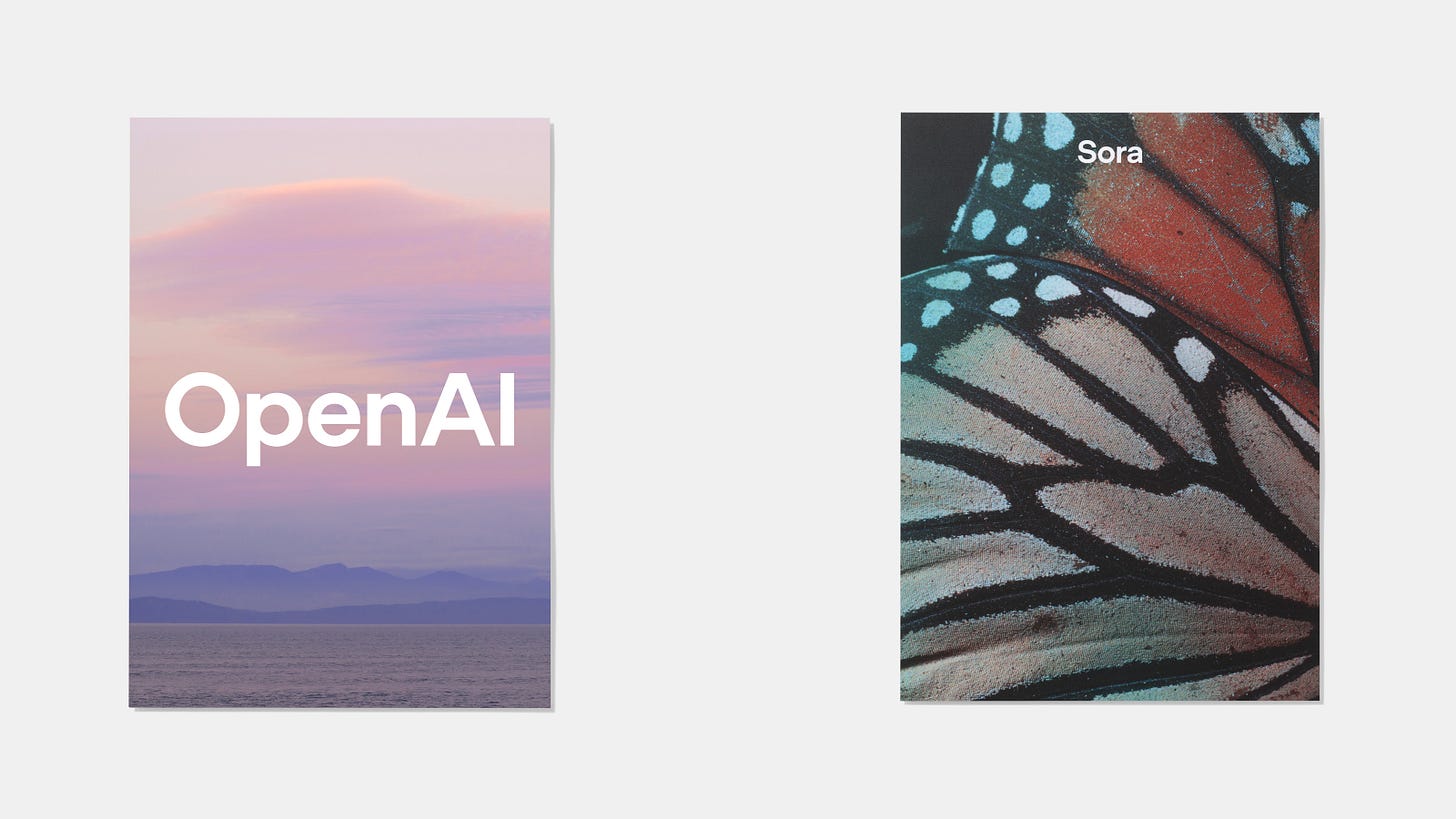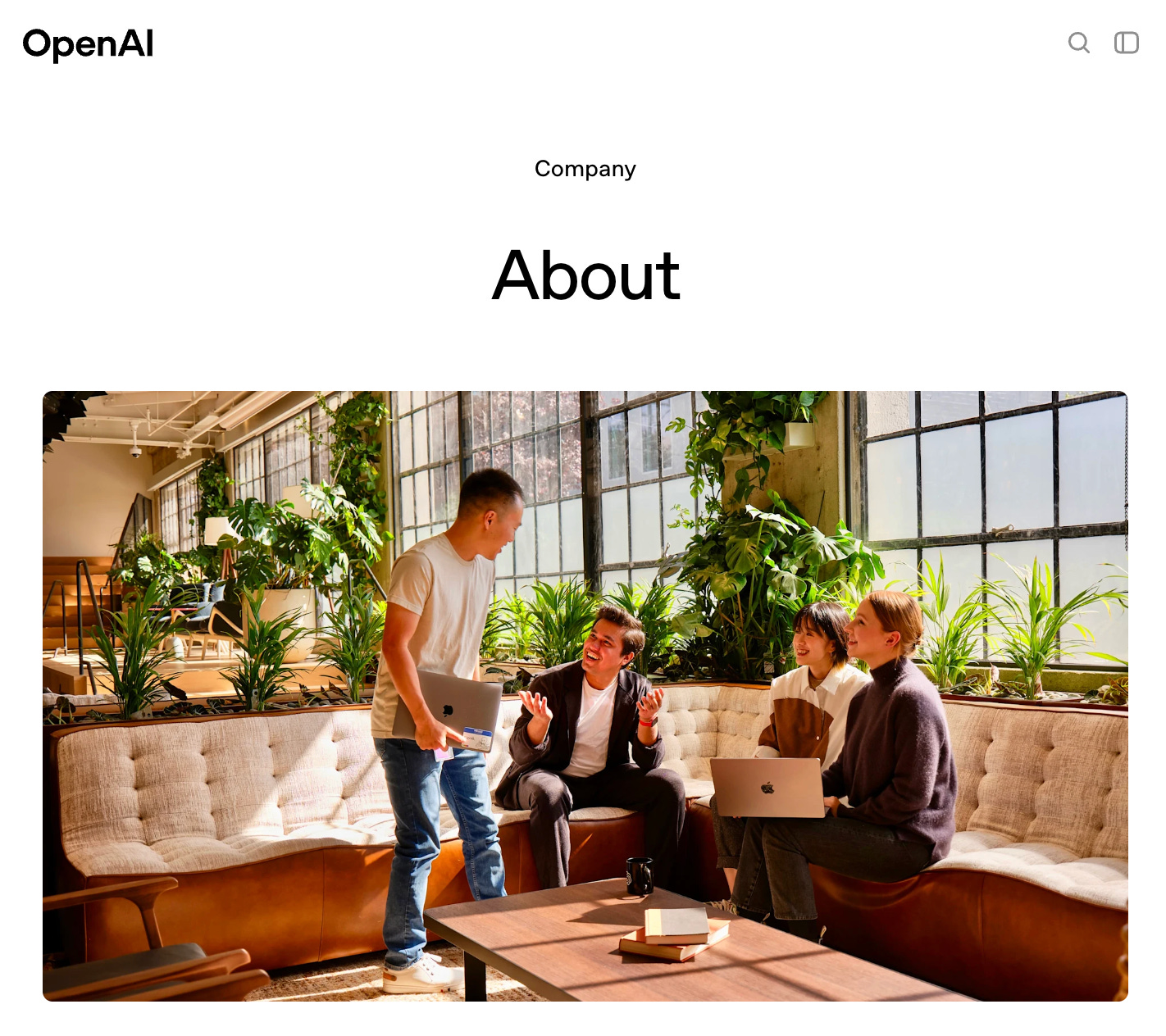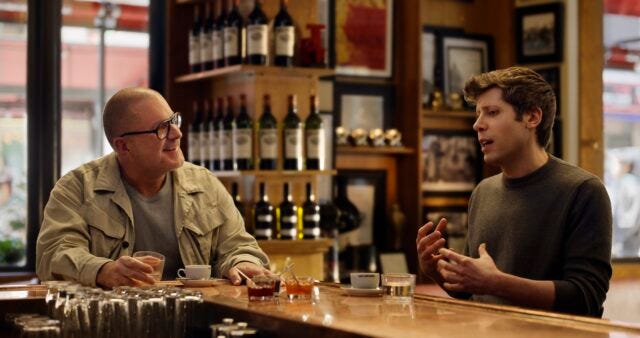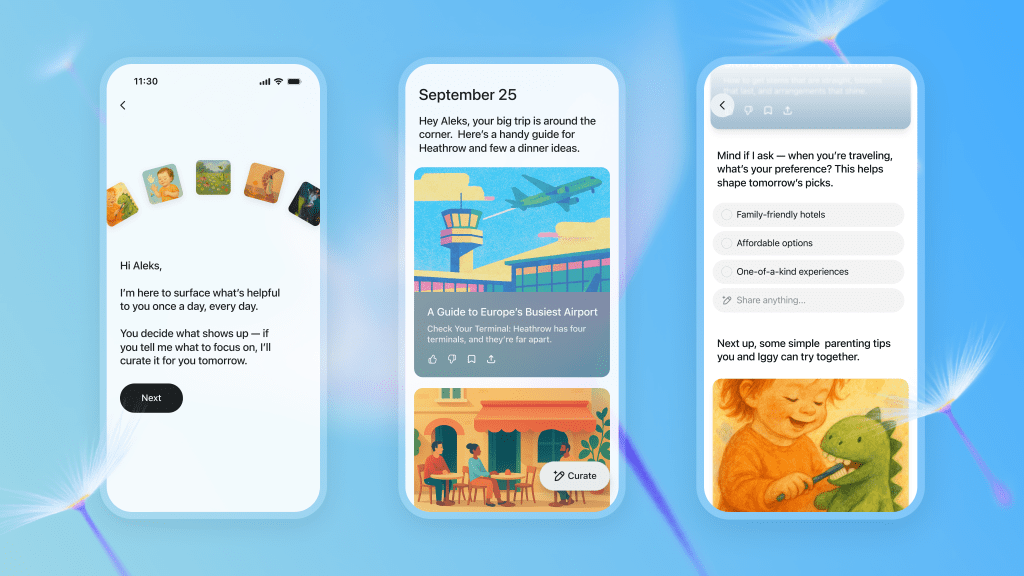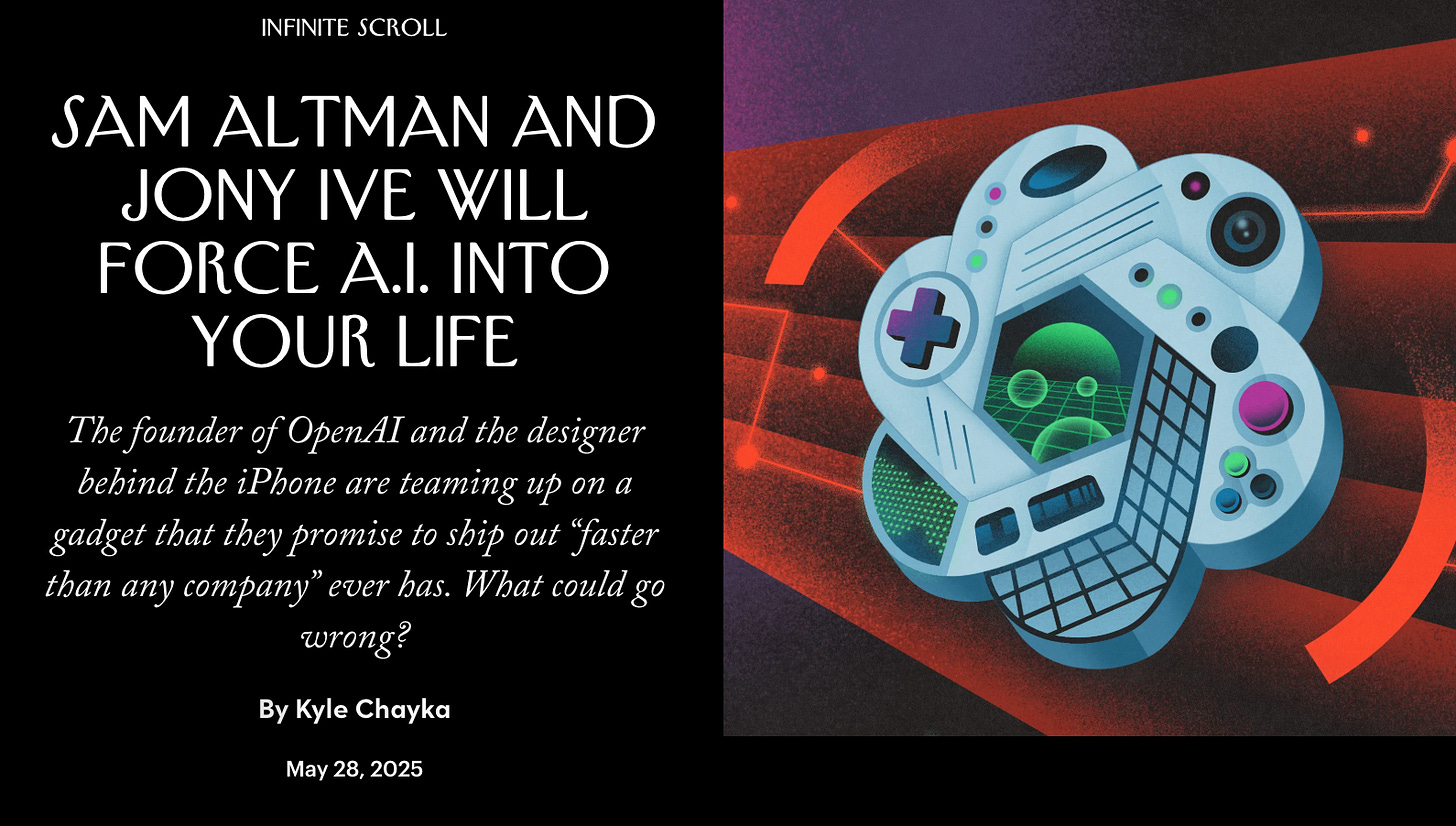⚫️ OpenAI: Marketing Case Study - The brand that makes tech feel human
ChatGPT went viral with no brand strategy. Now OpenAI rebrands, advertises and shows us what marketing in the age of AI can look like. Plus: 5 top learnings for our own marketing.
Hi 👋 I’m Florian Schleicher. This is the FutureStrategies newsletter. Thank you so much for reading along 💚
We’re chatting about everything with AI now:
Love, dating, job interviews, business, recipes, coaching.
My students write exams with it.
My inbox is full of AI cold calls.
LinkedIn? A river of AI-written posts.
And at the top of this trend is ChatGPT the product of OpenAI whose name has become synonymous with all AI assistants (like Google that now stands for searching something).
OpenAI interestingly doesn’t shout “AI” like everyone else. While most tech sites plaster buzzwords, OpenAI’s presence feels strangely… human. Real people. Real settings. Real voices. The product is sci-fi but the presentation is everyday.
That contrast is on purpose.
We’ll dive into what they get right, what’s replicable, and why they feel different - from naming, ads and product launches, to social. We will dive deep on OpenAI’s marketing strategy.
And the main question:
What makes them special and different to most AI companies marketing approach and what can we learn from it?
Let’s take a look at that here today:
1️⃣ From Research Lab to Product Hero
⚫️ The $14 Million Dot
3️⃣ Human First Branding
4️⃣ The future of AI (marketing)
5️⃣ 5 Learnings for our own Marketing Strategy
1️⃣ From Research Lab to Product Hero
Let’s take a look into the past:
OpenAI started in 2015 as a nonprofit research lab, talking about AGI (artificial general intelligence) safety more than consumer products. That changed overnight with the launch of ChatGPT in late 2022.
A “launch” that had nothing to do with marketing, as this tweet from Sam Altman, CEO of OpenAI, shows:
It was meant as a “research preview” but quickly went viral, hitting 100 million users in two months and suddenly turning a lab into a household name.
And when we are speaking about the name: That almost wasn’t ChatGPT.
Head of ChatGPT Nick Turley admitted the team was about to ship it as “Chat with GPT-3.5” - until a last-minute, late-night decision simplified it. They settled on ChatGPT, short for “generative pre-trained transformer.” CEO Sam Altman later joked that even ChatGPT is a “horrible” name, but it stuck and became shorthand for AI itself.
The company’s value has exploded from around $29 billion in 2023, to $157 billion in late 2024, to around $340 billion in early 2025.
“The chatbot has evolved from a prototype to a $4 billion revenue engine with 300 million weekly active users. It has shaken the foundations of the tech industry, even as OpenAI loses money (and cofounders) hand over fist while competitors like Anthropic threaten its lead.”
Kylie Robison, The Verge
But at the beginning, there was just a product, no brand, no marketing, not even a corporate design guide. But that all changed in 2025:
They invested in a Super Bowl ad, did a polished rebrand, and now have a surprisingly human Instagram account. All signals that OpenAI is ready to step onto the stage as a brand in its own right.
⚫️ The $14 Million Dot
It’s February 2025, Super Bowl Sunday.
And mixed with a lot of ads on cars and snacks - as per usual - OpenAI aired its very first ad. A 60-second spot that cost $14 million and placed the company in front of one of the largest mainstream audiences on earth.
But it was not what most, me included expected: The film didn’t lean on futuristic robots or synthetic voices. Instead, it used a single black dot - the blinking cursor we all see in ChatGPT - as its storytelling device.
Through pointillist animation, the dot morphed into fire, the wheel, flight, DNA sequencing, space exploration - a rapid montage of our human history of ingenuity.
The message was simple: Every leap forward begins with a starting point. The spot closed with ChatGPT itself and the line “All progress has a starting point.”
CMO Kate Rouch called it “the dawn of the intelligence age,” and explained the job of the ad was twofold:
Position ChatGPT as the next epochal tool in human history
and invite everyday people to “participate today” by trying it for themselves.
In other words:
The brand wanted to spark emotion, not fear. The ad marked the pivot from viral product to intentional brand - from usage to affinity. That balance made the spot stand out from typical AI hype.
Because here is the deal: If you go to most AI or tech websites, it is all about data, the future, the technical ingenuity. If you see any humans there, they are either already AI generated or it’s stock photography.
And here you have a spot, where OpenAI’s new video model Sora was used to prototype ideas, but the final animation was crafted entirely by human artists. As Rouch said:
“This is a celebration of human creativity”
And that was the first time that I paused and thought to myself:
Wait, why is this brand more about humans than technology?
3️⃣ Human First Branding
When we look at OpenAI’s brand today, what stands out most is what’s not there.
No sci-fi cityscapes. No faceless robots. No glossy “AI-made this” signatures.
Instead, the company has leaned into a human-first aesthetic that feels surprisingly analogue for the firm behind cutting-edge generative models.
Back last year, the design team around Veit Moeller were tasked with creating a new brand identity that was “more organic and more human,” without losing the sense of authority, technological sophistication and research-focused underpinnings.
“Human creativity is very much in evidence in the photography that launches the rebrand. The result of direct commissions to several contemporary practitioners, the imagery ranges from landscape to still life, to more abstract forms.”
Jonathan Bell, Wallpaper.com
This rebrand set the tone.
Storefront photography, natural textures, and AI-assisted but human-curated visuals made it feel less like a lab. More like a cultural brand.
That philosophy carried into OpenAI’s biggest advertising push yet, rolled out September 2025. Debuting on TV and rolling out across streaming, social, and outdoor, the campaign didn’t showcase futuristic demos or abstract data flows. Instead, it dramatized real moments of everyday life.
The ads are inspired by real life examples: A young man cooking a date-night dinner with ChatGPT’s help. Siblings planning a road trip. A student getting fitness tips. As CMO Kate Rouch put it:
“We’re showing their stories in ways that others can see and connect with… Our goal is for people to look at these moments and think, ‘this is for me.’”
It’s a sharp contrast to the Super Bowl ad’s grand arc of human history.
Now, OpenAI went small, personal, with real actors, real kitchens, real locations.
The brand emphasized that human craft was central - ChatGPT was only used behind the scenes as a “co-creator” for brainstorming ideas. Creative director Michael Tabtabai summed it up: as AI goes mainstream, OpenAI wants to show up “with humanity, creativity, and a clear focus on people.”
That’s not a trend, that’s just science:
„People are more likely to trust computer systems when they present cues that suggest a human is behind them.“
BJ Fogg, Stanford HCI Persuasive Technology
So OpenAI doesn’t scream “look what our model can do.”
It feels warm and with a touch of human awe.
OpenAI’s product launches follow the same principle: Instead of the polished, high-gloss theatrics you’d expect from an Apple event or the keynotes of Google and Meta, their launch events feel almost understated.
Their stage looks like a fancy living room, the presenters sit together casually, as if they were just having a coffee chat.
Yes there are tech-demos, but mostly it is a conversation (that sometimes feels a little bit too scripted). But even then, there is laughing, interrupting, the asking of follow-ups. It looked more like (nerdy) friends having a good time than engineers unveiling code. The message was clear: this isn’t a tool for the future, it’s a companion for your human everyday life.
I think all of this is very deliberate: While most of the AI-scene floods social with auto-generated content, OpenAI’s restraint signals trust and taste.
They know that they need to earn the trust of people and the best way to do that is by showing real people.
„We view a behavior as more correct in a given situation to the degree that we see others performing it.“
Robert Cialdini, Influence: The Psychology of Persuasion, 2009
And they are right to do so, if we look at the data.
If spotted 25% of consumers feel the brand is impersonal, and 20% feel it’s untrustworthy.
Even worse: Branded content starts looking the same.
So while using AI for marketing saves people time, its effectiveness at converting is falling behind human generated content. And even THE brand for AI content generation has adapted their approach accordingly.
And then there is one last example of this human touch in OpenAI’s marketing:
The “Sam & Jony” film - a 10 minute conversation between CEO Sam Altman and legendary Apple designer Jony Ive. It’s shot in a stripped-back, intimate style: two people in a simple setting of a bar during the day, warm lighting, no flashy effects.
The video feels almost like a design documentary, quiet, reflective.
By placing Altman next to Ive, OpenAI borrows the aura of timeless product design and grounds its narrative in human dialogue rather than technical spectacle.
There is nothing specific mentioned in the film, no tech specs, no roadmap - it’s about curiosity, values, and the role of design in shaping how we interact with intelligence itself. In a space where competitors default to demo theatrics, this understated collaboration signals maturity OpenAI framing itself not just as a tech company, but as a cultural design brand.
4️⃣ The future of AI (marketing)
The next frontier is already here.
With ChatGPT Pulse launched end of September 2025 and the coming wave of agents, AI will work asynchronously, learn from your goals, and act on your behalf. One step closer to the “promised” AI future of the movie HER.
But there are more questions:
This shift towards AI use for everyday tasks also reframes marketing: from chasing attention in endless feeds to designing how an assistant delivers value directly to a person’s day. For marketers, the real question will not be infrastructure but interface - how does your brand show up inside that flow of OpenAI? How does it reach limited attention spans, when no one uses search engines as before? When people don’t go to recipe sites anymore, but just ask their favourite chatbot?
How will OpenAI make money? Currently it is burning through investments, so monetization is the next open variable. Will the future of OpenAI come from more paid users, from ads layered into agents, or from an entirely new model we haven’t seen yet? If history is a guide, attention will once again be the currency, and that would make the user the product. But there is also the possibility of a new path, one where value is defined by outcomes instead of impressions.
And lastly, what product will we use to interact with OpenAI in the future? Currently it is our smartphone that has an app on it. But OpenAI hints at what another future could feel like. A device designed with Jony Ive that promises to be intimate, tactile, and human. An assistant that no longer just answers prompts but anticipates intent. A brand that presents technology not as spectacle, but as a trusted partner woven into daily life. Sam Altman, CEO of OpenAI, mentioned internally, that existing devices won’t suffice and that the device must break out of the smartphone/screen paradigm.
I have no answers to any of these now. But these are the things that I am thinking and reading a lot about.
5️⃣ 5 Learnings for our own marketing strategy
OpenAI’s brand story is unusual.
A research lab that never meant to build a consumer brand suddenly finds itself shaping culture. For a long time there was no apparent marketing strategy, no corporate design, not even a name that rolled off the tongue.
Here are 5 things that we can learn from their approach:
Show how your product can solve real problems.
OpenAI ads spotlight cooking, studying, planning - not something vague as “productivity” or “speed”. A great brand breaks down the added value it provides to a basic human need like love, community, health.Human marketing goes the distance.
The company most associated with artificial intelligence markets itself by looking more human than most tech products. In a world of infinite AI-made content, choose to look handmade and build trust through real imagery, real people, and human written texts.„Faces are special stimuli: they are processed holistically and automatically capture attention, conveying trustworthiness within milliseconds.“
Todorov et al., Trends in Cognitive Sciences
The name does not matter as much as most people think.
”ChatGPT” is, by the CEO’s own words, a “horrible name.” It still became the word people use to describe an entire category. I have heard so many wrong pronunciations of the name, like with people spelling “Too Good To Go” - the startup I was Head of Marketing for wrong all the time. What matters is being first, being useful, and being repeated in culture.Every touchpoint matters.
Oatly uses their packaging as a marketing medium. And OpenAI uses every video, like their product launches to make people feel their brand. Because: ”You cannot not communicate.” said the godfather of psychological communications theory Paul Watzlawick.Clarity through simplicity.
OpenAI’s strongest move is stripping away the noise. Their design language is minimal: one dot, one blossom, one typeface, one calm palette. Less is more. Especially in marketing. The simpler you can make it, the more people will remember you.
Final thoughts
I started this piece talking about how AI is already in our chats, inboxes, and classrooms. It is part of many people’s every day life. It has become part of my life for sure.
And now begins the interesting part, how will that relationship develop. Will it be a bland service like Amazon.com? Or inspire true brand love like Apple, Patagonia or LEGO?
OpenAI has become part of our everyday without shouting about AI at all.
For me, that’s the real lesson in their marketing.
Find out what problems people have.
Then satisfy that need, with products, services and communications.
That is also a very simple definition of what marketing is all about.
After diving deep on this upcoming, and still young brand, I believe a little bit more again in a future of tech that will feel human.
Let’s see how it turns out to be.
Thanks for reading along!


